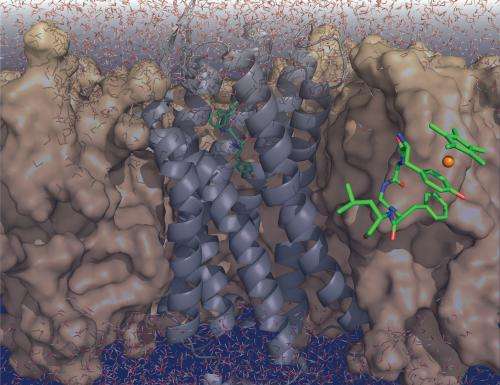Researchers decode the interplay between enkephalins and pain receptors

"Pain begone!" In order to send out this signal, the human body produces tiny messenger molecules that dock to certain receptors. Using traditional biochemical methods, this interaction between the messengers, so-called enkephalins, and opioid receptors is very difficult to study.
An interdisciplinary team of biochemists and inorganic chemists at the Ruhr-Universität Bochum (RUB) has now succeeded in identifying the structure of an enkephalin in solution and to track its interaction with the opioid receptor in detail. The analysis provides a new, precise starting point for the development of drugs meant to combat specific types of pain. This discovery is featured in the cover story of the Dalton Transactions journal.
Rhodium facilitates analysis of enkephalins in solution
Enkephalin is a peptide; it is made up of amino acids. Because it is very flexible in solution, researchers find it difficult to "grasp" the tiny molecule for the purpose of structural analysis. RUB chemists have deployed a trick: they have introduced a complex into the enkephalin that contains the precious metal rhodium and does not occur in nature. Subsequently, they have analysed the structure of the metal-peptide complex by means of nuclear magnetic resonance (NMR). With bound rhodium, it was possible to study the enkephalin much more extensively than ever before. Using computer simulation, the researchers then calculated how to optimally integrate the specific structure of the enkephalin, as identified by means of NMR spectroscopy, into the established three-dimensional structure of the receptor.
40 years after the discovery
Enkephalins were the first neuropeptides to be discovered and researched, but that did not happen until the 1970s. Related opioid receptors, members of the category of so-called G protein-coupled receptors, have eluded structural analysis for many decades, however. It was not until last year that some of their structures were decoded; moreover, the 2012 Nobel Prize in Chemistry being awarded for studies of G protein-coupled receptors has given this particular research field a new boost. "All of a sudden – some 40 years after enkephalins were discovered – we begin to understand on a nuclear level how these messengers bind to their receptors," says Prof Dr Nils Metzler-Nolte, head of the RUB research team Medicinal Inorganic Chemistry. "Our research shows that, by deploying metal complexes that do not occur in nature, we help solving questions in the field of medicine that have long remained unanswered," adds Prof Dr Raphael Stoll from the research team Biomolecular Spectroscopy.
More information: Wieberneit, F. et al. (2013): Structural and biological implications of the binding of Leu-enkephalin and its metal derivatives to opioid receptors, Dalton Transactions, DOI: 10.1039/C3DT50635E
Journal information: Dalton Transactions
Provided by Ruhr-Universitaet-Bochum


















